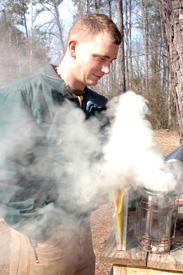Don Hopkins is used to challenges.
In his work as one of the state apiary inspectors for the last 18 years, he’s seen the effects of the conditions that, over the years, have ravaged populations of honey bees in the U.S. and North Carolina.
First it was the tracheal mite, which bred so rapidly in adult honey bees’ breathing tubes that it could suffocate the host.
The varroa mite came next, all but destroying the wild honey bee population in the U.S.
Just a few years ago, it was the small hive beetle, which ruined colonies with its burrowing larvae.
“About every seven years it’s something,” he said.
But since October, beekeepers up and down the east coast started noticing something new. Complete populations of adult honey bees were disappearing from their hives with no obvious cause.
No dead bodies. No obvious evidence of pests. No clear explanation.
“It doesn’t seem to be a result of the usual suspects,” David Tarpy, entomology professor and extension apiculturist, said. “There seems to be a new threat.”
It’s so new in fact, that researchers have just figured out what to call it — Colony Collapse Disorder.
The disorder gives the appearance of almost complete abandonment of the hive. The capped brood remains alongside the food stores, and even the pests so apt to rob colonies of their honey and pollen delay their attack noticeably.
“The fact that colonies are dying is not alarming,” Tarpy said. “It’s the manner in which they are dying.”
Details about the severity and the extent of CCD are unclear, but Tarpy said there is a “very serious underlying sense of concern” about the problem. It’s prompted the research community to swing into action, forming a CCD working group that works to constantly update the beekeeping community about their latest developments.
Tarpy is actually a part of this group, and is even in Florida this week attending one of their meetings. With a grant of about $10,000 from the National Honey Board, the bee lab at N.C. State is working to quantify the nutritional stress of the bees by measuring their protein content.
He said the disorder is the result of either a “causative agent,” a new syndrome in the mites or the result of environmental stress on the honey bees.
The trouble is, the sheer amount of variables makes it difficult to pin down an exact cause.
“There are new things introduced into agriculture all the time,” Tarpy said. “You’d think it was a static environment — it’s not.”
And according to Hopkins, the presence of other devastating pests isn’t making things easier either.
“If you look at all the other options and you can’t find any other condition, then you have a credible argument for Colony Collapse Disorder,” Hopkins said.
Hopkins said it’s also difficult to identify colonies that have been directly affected by the disorder, especially during the winter. During this time, honey bees rely on stored food and cluster in the hive to keep the queen at a constant temperature.
“This is when you’d have hive mortality anyhow,” Hopkins said.
Winter also means beekeepers check their hives less frequently because of the weather.
Charles Heatherly, president of the N.C. Beekeepers association, calls the timing of the disease a “double whammy” for beekeepers.
“The winter is not a good time to deal with this,” Heatherly said.
However, Heatherly said he is confident the working group will bring back substantial results for the community.
That same confidence is one of the reason’s why Hopkins said he is “realistically optimistic” about the problem. He said that although he expects Tarpy and the coalition to come back with more information soon, he said he can never be sure of the timeline.
“That’s up to the organism — if there is one,” he said. “The next four weeks will tell a lot.”
The real concern however, isn’t strictly the death of honey bees, but the affect that may have on growing season in North Carolina.
Pollination from honey bees equates to an average of about $154 million in annual crop productivity in North Carolina, according to the apiculture program. They are the predominant pollinators of cucumbers, blueberries, apples and melons.
With bees in short supply in the spring however, some growers may hit a bottleneck during the pollination season.
“The demand far outstrips the supply,” Tarpy said. “It might be even more difficult this year.”
Although Tarpy said there are more questions than answers now, he did express confidence that the challenges beekeepers have faced in the past may help to solve the problems caused by CCD.
After all, this isn’t the first time the community has dealt with a “disappearing disease.” The symptoms of tracheal mites, he said, were characterized in a similar fashion before they were identified.
“There’s always a rational explanation,” Tarpy said.








